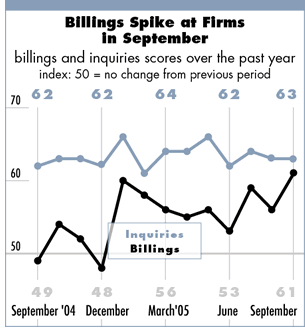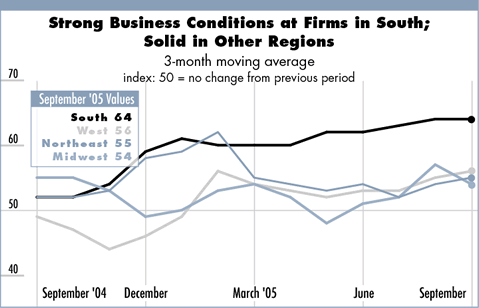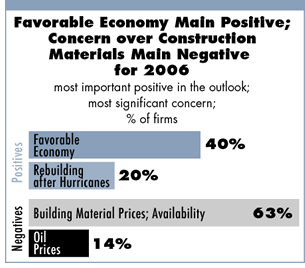

10/2005
2006 business projected to increase modestly, despite concerns about pricing and construction materials availability

by
Kermit Baker, PhD, Hon. AIA
Chief Economist
 Billings at architecture firms jumped in September,
generating a reading of 60.5 on the AIA’s Architecture Billings
Index (ABI). Any score above 50 indicates an increase in billings at
U.S. architecture firms, and the September reading is the highest recorded
monthly gain since the summer of 1998 for this survey of business conditions.
Research conducted by the AIA has found that changes in design activity
precede changes in construction activity by almost two quarters. Recent
increases in design activity can be expected to produce similar changes
in construction activity in early 2006.
Billings at architecture firms jumped in September,
generating a reading of 60.5 on the AIA’s Architecture Billings
Index (ABI). Any score above 50 indicates an increase in billings at
U.S. architecture firms, and the September reading is the highest recorded
monthly gain since the summer of 1998 for this survey of business conditions.
Research conducted by the AIA has found that changes in design activity
precede changes in construction activity by almost two quarters. Recent
increases in design activity can be expected to produce similar changes
in construction activity in early 2006.
Inquiries for new design projects scored 62.5, indicating expected future growth in design activity. However, the pace of growth for project inquiries in September eased a bit from its July and August levels.
Firms in all regions reported improvement in business conditions. However, firms in the South reported the strongest improvement, with an ABI score of 64.3. Scores for firms in other regions averaged in the mid-50s for September. By area of specialization, commercial/industrial design firms (those with over 50 percent of their design billings in these sectors), as well as institutional design firms reported healthy business conditions. Residential firms, although still reporting gains, indicated that growth in billings has been slowing in recent months.

Inflation becoming a player
With recent spikes in oil and gasoline prices, as well as increases in
selected construction commodities, inflation has become central to
the economic outlook. With rising energy costs, consumer prices increased
by 1.2 percent in September, the largest monthly increase since 1980.
Overall, inflation has increased 4.7 percent over the past 12 months.
Without the volatile food and energy components of the consumer price
index, inflation increased a more manageable 2.0 percent over the past
year.
The post-Katrina employment numbers took a hit; payrolls declined by 35,000 positions in September, the first decline since early 2003. However, construction employment increased by 23,000 positions in September, so the general slowdown in the economy brought about by the hurricanes has not been felt by this sector. The consumer and business sentiment numbers remain depressed. The Conference Board’s CEO business confidence survey declined in the third quarter after having slipped in the second quarter. The University of Michigan’s preliminary consumer sentiment reading for October dropped a bit more from its steep decline in September.
 Most firms expect
increased billings in 2006
Most firms expect
increased billings in 2006
Business conditions at architecture firms have improved in recent quarters,
and firms generally expect further gains in 2006. Overall, over half
of firms surveyed expect their billings to increase at least 5 percent
next year. Over a third of firms expect billings to remain within 5
percent of 2005 levels. The remaining 15 percent expect to see decreases
next year. Overall, firms expect billings to increase 4.2 percent in
2006.
Firms in the South expect increases of 5.3 percent on average, over two percentage points higher than firms in the Midwest (3.1 percent). Larger firms (with billings in excess of $5 million) expect billings to grow 5.6 percent on average, double the rate of firms with billings between $250,000 and $1 million. Commercial/industrial firms are projecting billings increases of 6.4 percent next year, well in excess of residential firms (4.4 percent), institutional firms (4.2 percent), or those with a mixed practice (3.6 percent).
Generally favorable economic conditions for construction (low interest rates, moderate rates of inflation overall) are seen by 40 percent of firms as the main positive in the design and construction outlook for 2006. Also scoring high was rebuilding after the hurricanes (21 percent), increased need for space by U.S. businesses with an improving economy (18 percent), and pent-up demand after several years of weak business conditions (17 percent).
Potential problems with availability and pricing of building materials was seen by 63 percent of respondents as the most significant concern in the design and construction outlook. Rising oil prices were mentioned by 14 percent of respondents as the most significant concern for the outlook; growing international tensions was mentioned by 12 percent, while 7 percent mentioned rising interest rates.
Copyright 2005 The American Institute of Architects.
All rights reserved. Home Page ![]()
![]()
 |
||
This month, Work-on-the-Boards survey participants are saying: • Business remains very robust, with a 4-6 month backlog
for work. • Clients want lower and lower fees based largely on the
never-ending increase in construction costs. • The hurricane has made business very difficult. Our office
flooded. Everyone should have a disaster recovery system and a
way to get in touch with employees. We were very fortunate to retain
most employees and salvage electronic data. • Public funding sources for projects (especially historic
preservation related work) seem to be somewhat tighter, and the
long range forecast is foggy or negative.
|
||